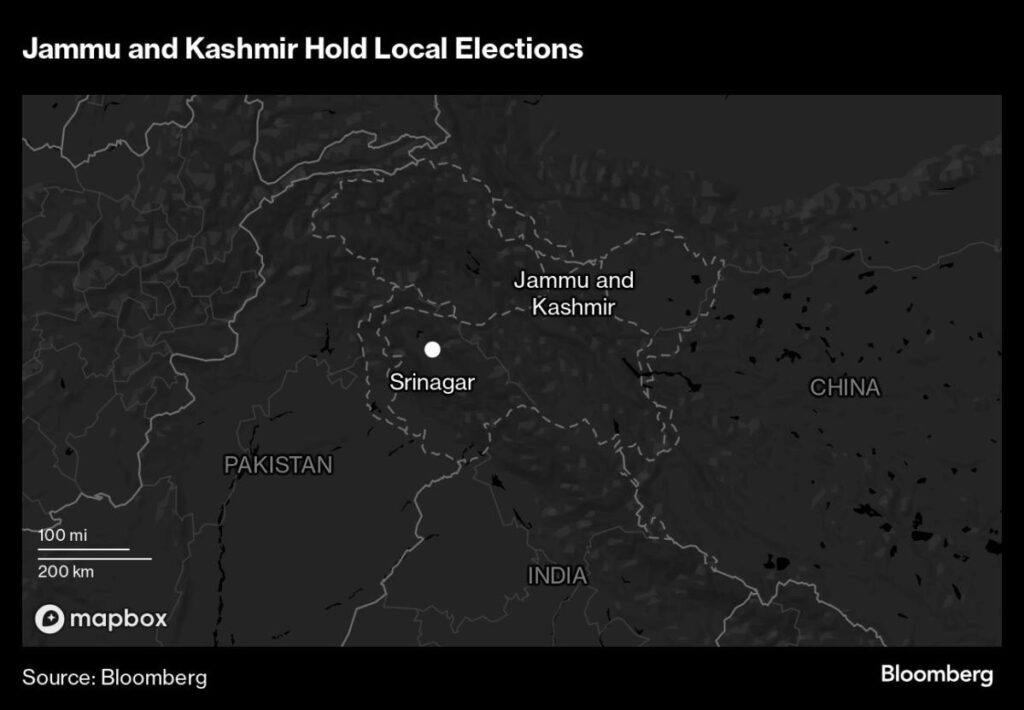(Bloomberg) — India’s northernmost region, Jammu and Kashmir, will conclude local elections on Tuesday as concerns grow about an uncertain outcome that could slow economic progress in the restive province.
Most read from Bloomberg
The only Muslim-majority region in Hindu-dominated India held three phases of elections from September 18. About 8.7 million registered voters elect candidates for 90 parliamentary seats. The party with half the seats can form the government and choose its prime minister, although it is more likely that a group of parties will have to form a governing coalition.
The results will be announced on October 8, along with the results of the local elections in the northern state of Haryana.
Prime Minister Narendra Modi’s Bharatiya Janata Party faces stiff competition from regional groups in Jammu and Kashmir, which have typically ruled there, and the Indian National Congress, the country’s main opposition party.
The Congress party has allied with the Jammu and Kashmir National Conference, one of the key regional groups, to keep the BJP out. They are campaigning on a promise to restore statehood after Modi’s government stripped the region of its semi-autonomy in 2019 and abolished constitutional guarantees that gave residents special rights. Since then, Jammu and Kashmir has been directly controlled by the federal government in New Delhi.
Another major regional party, the People’s Democratic Party of Jammu & Kashmir, suggests that parliament is heading towards a hung assembly, with no party or coalition having enough support to govern.
“This election in J&K has left most political analysts baffled,” Iltija Mufti, daughter of PDP leader Mehbooba Mufti, a former ally of the BJP, said in a post on will occur at all. will it win the majority or will it be another spell of an apathetic central rule.”
Iltija said in an interview last month that her party is open to working with rivals to stop the BJP from forming a local government.
The prospect of a hung meeting or protracted coalition talks could further slow progress in the region. The Kashmir Valley lies on the edge of a disputed territory with Pakistan and has seen three wars and several skirmishes over the years. As a result, the region has not seen the kind of development and investment that the rest of India has experienced.
A non-BJP government in the region, still ultimately controlled by the federal government in New Delhi, could still be hampered in policymaking.
An agreement with several players “does not contribute to stability” in the region, says Rasheed Kidwai, a political analyst and author on Indian politics. Regional parties want a restoration of statehood, and if they win “we will see a confrontation between New Delhi and Srinagar in the next five years,” he said.
The BJP is contesting 62 of the 90 seats up for grabs and is leaning on other regional parties and independent candidates to boost its support in the assembly. The party’s campaign focused on promises to create 500,000 jobs, bring in investments and provide handouts such as free laptops and scholarships to students.
Modi is usually an energetic campaigner for the party in state elections and has held only one rally in Srinagar, the Kashmiri capital. The BJP has concentrated its campaigns in the Hindu-dominant Jammu region, where 43 seats are at stake.
The Congress Party and its allies are vying for all ninety seats eligible for the assembly.
The latest turnout in the final phase of the election was about 66% and the previous two phases averaged about 60%, higher than in previous polls, a sign that voters may be motivated by a state’s message. Though the BJP has promised to restore Jammu and Kashmir to statehood from a union territory, this has stalled over the years.
“The decisions taken by New Delhi in 2019 are a major focus of the election campaign and have led to increased participation in the elections,” said Ayjaz Wani, fellow at the Observer Research Foundation.
(Updates with latest attendance figure in fifteenth paragraph)
Most read from Bloomberg Businessweek
©2024 BloombergLP

